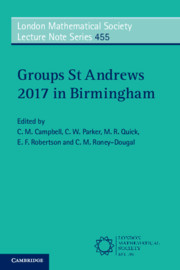Book contents
- Frontmatter
- Contents
- Introduction
- Finite Simple Groups and Fusion Systems
- Finite and Infinite Quotients of Discrete and Indiscrete Groups
- Local-Global Conjectures and Blocks of Simple Groups
- A Survey on Some Methods of Generating Finite Simple Groups
- One-Relator Groups: An Overview
- New Progress in Products of Conjugacy Classes in Finite Groups
- Aspherical Relative Presentations all Over Again
- Simple Groups, Generation and Probabilistic Methods
- Irreducible Subgroups of Simple Algebraic Groups – A Survey
- Practical Computation with Linear Groups Over Infinite Domains
- Beauville p-Groups: A Survey
- Structural Criteria in Factorised Groups Via Conjugacy Class Sizes
- Growth in Linear Algebraic Groups and Permutation Groups: Towards a Unified Perspective
- L2-Betti Numbers and their Analogues in Positive Characteristic
- On the Pronormality of Subgroups of Odd Index in Finite Simple Groups
- Vertex Stabilizers of Graphs with Primitive Automorphism Groups and a Strong Version of the Sims Conjecture
- On the Character Degrees of a Sylow p-Subgroup of a Finite Chevalley Group G(pf) Over a Bad Prime
- Patterns on Symmetric Riemann Surfaces
- Subgroups of Twisted Wreath Products
- Some Remarks on Self-Dual Codes Invariant Under Almost Simple Permutation Groups
- Test Elements: From Pro-p to Discrete Groups
- References
Finite Simple Groups and Fusion Systems
Published online by Cambridge University Press: 15 April 2019
- Frontmatter
- Contents
- Introduction
- Finite Simple Groups and Fusion Systems
- Finite and Infinite Quotients of Discrete and Indiscrete Groups
- Local-Global Conjectures and Blocks of Simple Groups
- A Survey on Some Methods of Generating Finite Simple Groups
- One-Relator Groups: An Overview
- New Progress in Products of Conjugacy Classes in Finite Groups
- Aspherical Relative Presentations all Over Again
- Simple Groups, Generation and Probabilistic Methods
- Irreducible Subgroups of Simple Algebraic Groups – A Survey
- Practical Computation with Linear Groups Over Infinite Domains
- Beauville p-Groups: A Survey
- Structural Criteria in Factorised Groups Via Conjugacy Class Sizes
- Growth in Linear Algebraic Groups and Permutation Groups: Towards a Unified Perspective
- L2-Betti Numbers and their Analogues in Positive Characteristic
- On the Pronormality of Subgroups of Odd Index in Finite Simple Groups
- Vertex Stabilizers of Graphs with Primitive Automorphism Groups and a Strong Version of the Sims Conjecture
- On the Character Degrees of a Sylow p-Subgroup of a Finite Chevalley Group G(pf) Over a Bad Prime
- Patterns on Symmetric Riemann Surfaces
- Subgroups of Twisted Wreath Products
- Some Remarks on Self-Dual Codes Invariant Under Almost Simple Permutation Groups
- Test Elements: From Pro-p to Discrete Groups
- References
Summary
We’ll begin with an introduction to the basic theory of fusion systems. Then we give an overview of the proof of that part of the CFSG devoted to the groups of component type, after which we discuss how to translate that proof into the category of 2-fusion systems, and indicate some advantages that accrue from that translation. We also describe some other changes to the original proof of the CFSG that are part of the program.
- Type
- Chapter
- Information
- Groups St Andrews 2017 in Birmingham , pp. 1 - 15Publisher: Cambridge University PressPrint publication year: 2019
References
- 1
- Cited by

